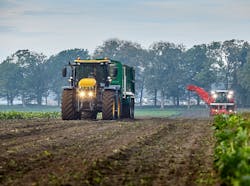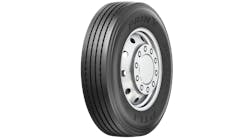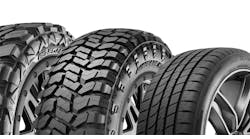Modern Tire Dealer has partnered with AG Tire Talk to provide answers to insightful questions that farm tire dealers have about farm tire technology. This is the 12th in an ongoing series, which is designed to help farm tire dealers better connect with their customers. A trending question, followed by an abridged version of the answers, will appear in our Commercial Tire Dealer section every other month. For complete answers, check out www.agtiretalk.com!
QUESTION: In four-wheel-drive (4WD) tractor applications, if an implement requires 550 horsepower (hp) and standard dual tires are not providing adequate traction — and you can’t go wider with triples — what is your recommendation?
Nick Phillippi, national product manager, Alliance Tire Americas Inc. With massive loads and high horsepower, today’s tractors are placing huge demand on tires. There are three levels of commitment an operator can undertake when it comes to maximizing tire and equipment performance: managing inflation pressure (easiest); switching to low-pressure tires (moderately challenging); and ideally, using a central tire inflation system, or CTIS, to maintain optimal pressure (fully committed.)
With tires, it’s all about inflation pressure. With a massive tire like a size 800/70R38, the difference between 23 psi, which many farmers will inflate to because it’s easy, and 12 psi, which is optimal for field work, is night and day. Just dropping to that lower inflation pressure level is enough to transform a tractor into something the farmer didn’t even know he had.
The next step, especially with a huge tractor, is switching to very high flexion (VF) tires. It is possible to “over-tire” a tractor but with a Steiger 620, for example, you’re talking about 50,000 pounds of machine. With that kind of load, VF tires will pay off all day long, especially because they can handle the same load as a conventional radial with 40% less inflation pressure. That allows you to get down as far as 8 psi or even 6 psi. Of course, the best way to get duals to a maximum level of traction is to lower inflation pressure in the field and only increase it on the road.
As much as we would love to see farmers stop on the edge of their field to adjust inflation pressure, the most practical way to ensure that the right pressure adjustments are made would be to install a CTIS, especially if an investment has been made in VF tires. CTIS technology allows the operator to adjust inflation pressure levels with an onboard compressor at the touch of a button. In just a couple of minutes, a set of tires can be adjusted to optimal inflation for either field or pavement.
Dave Paulk, manager of field technical services, BKT USA Inc.: Managing traction is important to controlling costs and efficiencies on a farm. Too much tire slippage can increase fuel and labor costs. The more lugs that can be put on the ground, the better traction and performance will be.
When high-horsepower tractors are used with heavy implements, higher air pressures may be required to support the increased weight. Higher air pressures in standard-rated tires can lead to less traction, more slippage and an increase in soil compaction. Having the ability to reduce air pressure levels with damaging the tire will give a larger footprint and better traction.
Tires with increased flexion (IF) and VF technology may help with traction and lead to less slippage and better flotation. IF tires are rated to carry 20% more weight at the same air pressure as a standard tire. VF tires are rated to carry 40% more weight at the same air pressure as a standard tire. If a tire can carry the same weight at 20% or 40% less pressure, this allows for a larger — and wider — footprint, with more of the tire and lugs on the ground for traction. This allows less slippage and enhanced fuel savings.
Tires also provide better traction as their inflation pressure levels are decreased. IF and VF tires enable a tractor to carry more weight on the road without having to widen the tractor with triples.
Bradley Harris, manager, global agricultural field engineering, Firestone Ag Division, Bridgestone Americas Tire Operations LLC: When users complain about traction in the field, the first thing that needs to be done is to make sure the tractor is set up correctly. Loss of traction could be due to under- or over-ballasting of the tractor, too high inflation pressure or use of liquid ballast in tires. Before we recommend different tire sizes or technologies, let’s get the tractor set up correctly.
For a 4WD tractor, the target ballast weight is 110 pounds per engine horsepower in heavy draw bar pull. A 620 hp 4WD tractor should have a base weight of 68,200 pounds. The weight needs to be distributed so that 51% to 55% is on the front axle and 45% to 49% is on the rear axle.
The front axle target weight would be between 34,782 pounds and 37,510 pounds. The rear weight would be between 33,148 pounds and 30,690 pounds. I recommend using steel ballast to obtain the weight on the tractor. Using liquid ballast does not damage the tire, but liquid does not compress. Liquid will prevent sidewalls from properly deflecting and will make the tire stiffer. This extra stiffness keeps the tire from developing a full footprint, reducing traction in the field. By using the ballast calculator provided by the tractor manufacturer, the machine can be ballasted with the available steel weight package.
With the front and rear axle weights set to utilize the engine’s horsepower, the minimum inflation pressure for the tires can be calculated. Assuming the tractor has dual, size 710/70R42 tires, the inflation pressure needed to carry 32,700 pounds on the rear axle is 17 psi. Setting the pressure to these weights allows tires to develop the largest possible footprint. The pressure in the tires also determines what the ground contact pressure is. In this set-up, the ground contact pressure is 22 psi on the front axle and 17 psi on the rear axle.
If the tractor is set up correctly and it still does not seem to have the required traction, then it is time to look at IF or VF tires. These tires can carry the same axle loads at lower inflation levels, which allow the tires to deflect more. This allows the footprint to increase in length.
Greg Gilland, business development and ag segment manager, Maxam Tire International. Each agricultural operation requires equipment designed to maximize the transmission of a tractor’s horsepower to pull the desired implement through the field. In the case of 4WD tractor applications, the choice of machine brand and horsepower available will dictate the options or size of tires that can be employed to deliver the traction expected to pull large implements.
Agricultural tires are designed — based on their size geometry, materials and air chamber — to carry a certain amount of weight at a given ground speed and to fit a certain wheel-base. In 4WD tractors, the ongoing challenge is to reduce the size or width of the tractor despite the fact that with larger implements on the design board, more horsepower is being applied to all new 4WD tractors coming to the ag market.
One solution that has been tested with successful results is to convert a tractor to a larger-diameter, very high-flexion tire that simultaneously provides the tractor with a reduced width solution and greater traction. When challenged with a 550 hp tractor that needs greater pulling power at reduced widths, convert your tractor to larger-diameter tires that can be used in duals. This will give you greater traction and footprint, and a reduced machine width. VF technology continues to bring new solutions that are redefining the use of tires to meet the growing challenge of larger, more powerful tractors.
David Graden, operational market manager, Michelin North America Inc.: In the case of a 4WD tractor pulling an implement that requires 550 hp, there are several cost-effective tire options that can do the job. First, begin by listing your needs:
- Traction
- Torque transfer
- Limited width
Also, are you concerned about fuel economy? Do you have the need to travel between fields at a decent rate of speed? Have you considered soil compaction and the proven effects on yield? And have you looked at different machines and price gaps between each?
Typical tire sizes found on high-horsepower machines are 710/70R42 and 800/70R38. I would recommend going with VF tires in these sizes.
Let’s look at the air pressure that’s required to transfer 550 hp. When calculating optimal tire pressures, we need to first know what the machine weighs and then calculate the proper weight distribution required to transfer torque to the ground.
At six miles per hour, these machines will require about 95 pounds per engine horsepower. That comes to 52,250 pounds total. Next, you want about 55% of that weight on the front axle and 45% on the rear axle. This weight distribution will eliminate power hop and road loping.
For each of these tires, the front axle air pressure for field operation is nine psi and the rear axle air pressure for field operation is six psi. For roading, with a CTIS, you can then increase the air pressure to the maximum psi listed on the sidewall of each tire and travel at maximum machine speed. In addition to transferring 550 hp to the ground, if you want higher road speeds, less fuel consumption, increased yields and an overall lower total cost of ownership, our recommendation is to pair a premium VF tire with a CTIS.
Scott Sloan, ag product manager/global LSW, Titan International Inc.: The key to any high-draft load/heavy tillage application requires three things. First, the tractor must be ballasted heavily enough to pin the power to the ground. As discussed in previous articles, we recommend 90 pounds to 120 pounds per horsepower as a guideline for total machine weight. Additional ballast may be needed to achieve proper machine weight.
Secondly, along with total wight, front to rear weight distribution also is critical. We recommend a 60 front/40 rear weight split as a target. Lastly, once the tractor is ballasted correctly, inflation pressure must be set for optimal performance.
Norberto Hebener, OE applications engineer, Trelleborg Wheel Systems. Every farmer strives for the highest efficiency on power and torque transfer from his tractor to the ground. He seeks the lowest slippage, the lowest fuel consumption, the lowest compaction and the fastest possible speed. Not all conditions can be achieved, yet many combinations can be applied to meet the farmer’s needs. Each of the following elements must be considered.Ballast. First, consider the transfer of power to the ground. It starts with balancing the total tractor weight and its power. There are general rules to follow when determining this balance. Heavy tillage must consider between 100 pounds and 120 pounds per tractor engine horsepower. As for weight distribution between front and rear axles, it will depend on how much down-force the implement applies to the rear axle. Broadly speaking, a starting point of 55% front and 45% rear — and up to 60% front and 40% rear — is the right ratio.
Inflation pressure. Secondly, focus on how to transmit power to the ground. Tires must be adjusted to monitor inflation pressure per the tire manufacturer’s recommendation. Once the correct weight for the tractor has been established, we may define the correct inflation pressure, depending on what speed we intend to drive the tractor.
Speed. On conventional tires, the load capacity increases when we reduce the working speed at the same inflation pressure. It is important to be aware of the speed at which the tractor/implement will be working. Following the tire manufacturer’s recommendations to help ensure the tire footprint is the largest possible for the load. One point to consider when using dual fitments is that the load capacity is reduced by 12% on each tire, which means that the load capacity should not be doubled.
Ken Brodbeck, vice president of technology, Precision Inflation LLC. An implement requiring 550 hp is definitely a heavy tillage requirement and demands the tractor be set up specifically for this high draw bar application. The tractor must have all of the following attributes properly set in order to provide comparable draw bar pull to track machines:
Tires: Base or standard tires may need to be up-sized to wider, higher load capacity tires. Standard 620 or 710-width tires should be replaced with size 800/70R38 IF tires for the widest and longest footprint possible.
Tractor ballast. For heavy tillage, 4WD tractors require more ballast. If 4WD wheel slip is over 8% to 10%, more ballast is required. Typically, the rule of thumb is 105 pounds per engine horsepower.
Tire pressure. Sometimes an implement dealer will over-inflate the original tires or use the same, smaller-tire psi for a larger tire. Over-inflation shrinks the footprint and makes the tractor prone to power hop and wheel slip. The tractor needs to be weighed on a scale or you can estimate weight using the tractor manufacturer’s ballast calculator to determine both front and rear axle loads. Tire pressure levels then need to be set one psi to three psi above the minimum tire pressure, unless the machine has a CTIS that allows tire pressure levels to be maintained daily. ■
Balancing act: Start by determining gross weight per tractor axle
The first thing to do when confronting the issue described at the start of this month’s edition of AG Tire Talk is to determine the gross weight per axle of the tractor, says Jim Enyart, technical manager, CEAT Specialty Tires Inc. For example, the base weight of a John Deer 9620 is 43,420 pounds. The tractor’s engine is rated from 370 hp to 620 hp.
“The minimum recommended gross weight should be 62,000 pounds, with 60% of the weight on the front axle and 40% on the rear,” he says. “You need to add a minimum of 18,850 pounds of additional weight via suitcase, axle or wheel weights. If adding weight does not accomplish gross weights or weight distribution, you can add weight via liquid ballast.” Enyart then recommends checking inflation pressure levels on all tires. “Normal inflation pressures for this set-up would be 10 psi in the front and eight psi for the rear tires. You may be able to lower your inflation pressure levels but you need to consult the tire manufacturer’s load and inflation tables before you do this. If the gross weight and distribution are correct and traction is still an issue, you should add (extra) weight — approaching a gross weight of 74,400 pounds, with the appropriate distribution.”
Another option, he says, is to rent or borrow a smaller implement that has lower power requirements.



